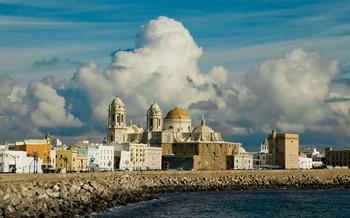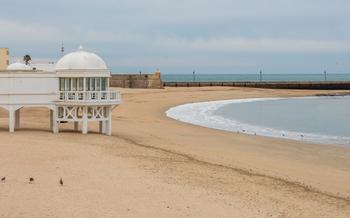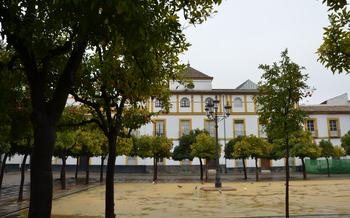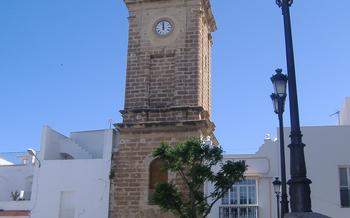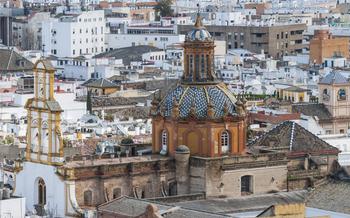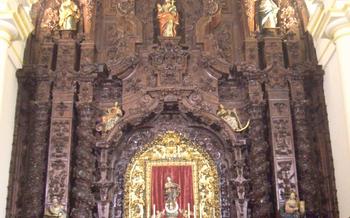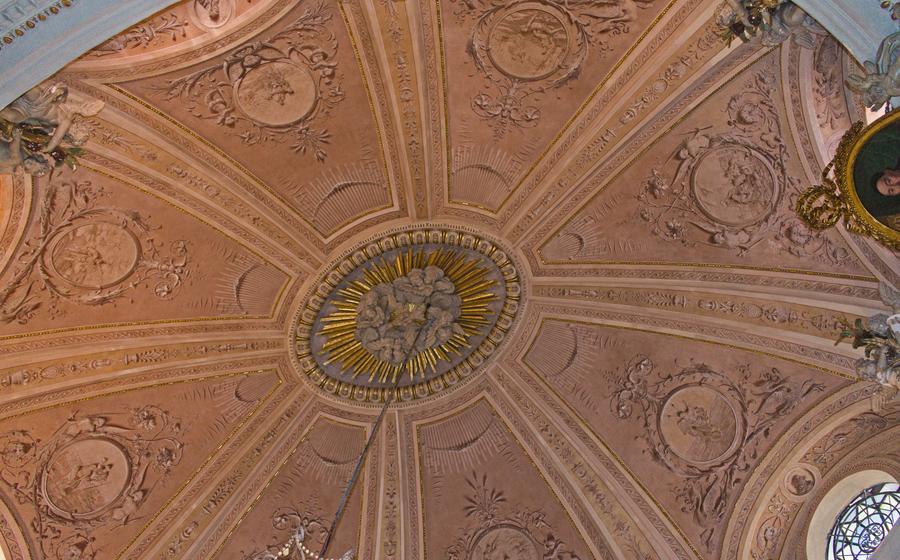
Oratorio de la Santa Cueva
- Oratorio de la Santa Cueva: A Sacred Gem in Cádiz
- Location and Getting There
- Hidden Chapel of the Virgen de los Remedios
- Oratorio's Role in Holy Week Celebrations
- Exquisite 18th-Century Altarpiece
- The Oratorio's 16th-Century Origins
- The Miraculous Image of Cristo del Perdón
- The Oratorio's Impressive Choir Stalls
- The Oratorio Courtyard and Sacristy
- The Oratorio's Celebrated Frescoes
- The Oratorio's Rooftop Terrace: A Breathtaking Panorama
- Insider Tip: The Oratorio's Tranquility at Dawn
Oratorio de la Santa Cueva: A Sacred Gem in Cádiz
In the heart of Cádiz, nestled within the historic neighborhood of El Pópulo, lies a hidden treasure that beckons pilgrims and art enthusiasts alike: the Oratorio de la Santa Cueva. This sacred sanctuary, dedicated to the Virgin Mary and the saints Servando and Florentina, holds a profound religious significance for the people of Cádiz. For centuries, devout believers have flocked to the Oratorio, seeking solace, offering prayers, and paying homage to the revered relics housed within.
The Oratorio's reputation as a pilgrimage site stems from its association with the miraculous image of the Cristo del Perdón (Christ of Forgiveness). Believed to possess extraordinary powers, this crucifix attracts a multitude of devotees who come to seek blessings, offer gratitude, or simply marvel at its captivating beauty.
Beyond its religious significance, the Oratorio is a treasure trove of artistic wonders. The 18th-century altarpiece, with its intricate carvings and vibrant colors, is a masterpiece of Baroque art. The choir stalls, meticulously crafted from wood, showcase the exceptional craftsmanship of the era. And the Oratorio's walls are adorned with exquisite frescoes, depicting scenes from the lives of Christ and the saints, adding to the overall splendor of this sacred space.
Prepare to be captivated as you step into the Oratorio de la Santa Cueva, where history, art, and spirituality converge to create a truly awe-inspiring experience.
Location and Getting There
The Oratorio de la Santa Cueva is conveniently located in the heart of Cádiz's historic center, at the Plaza de la Catedral. To reach this sacred gem, you can take a scenic stroll from the renowned Cádiz Cathedral, which is just a stone's throw away. Alternatively, you can hop on the efficient public transportation system, with buses stopping right outside the Oratorio, making it accessible from various parts of the city.
If you prefer to explore at your own pace, walking or cycling are excellent options, allowing you to soak in the vibrant atmosphere of Cádiz's charming streets. And for those arriving by car, there are several parking options nearby, including the Plaza de las Flores car park, ensuring a hassle-free visit.
Hidden Chapel of the Virgen de los Remedios
In the depths of the the Virgen de los Remedios. Its discovery in 1929 unveiled a sacred chamber concealed behind centuries of history. Legend has it that this chapel was a secret refuge for persecuted Christians during the Moorish occupation, a testament to the enduring faith of Cádiz's people.
The chapel's centerpiece is a revered statue of the Virgin Mary, known as the Virgen de los Remedios, patroness of Cádiz. This wooden effigy, crafted with exquisite detail, exudes a serene aura that draws pilgrims and visitors alike. Believed to date back to the 15th century, the statue holds deep significance for the city's maritime community, who seek her protection and guidance on their seafaring journeys.
A visit to the hidden chapel offers a glimpse into the spiritual heart of Cádiz. Its walls adorned with intricate azulejos and delicate paintings narrate the stories of the Virgin Mary's miracles and interventions throughout history. The atmosphere is one of reverence and devotion, where visitors can pause and reflect on the enduring power of faith and the unwavering love of the Virgin Mary for her city.
To access this hidden gem, visitors must descend a narrow staircase tucked away in the Oratorio's sacristy. The chapel is small and intimate, with limited visitor capacity, creating an air of exclusivity and tranquility. Visitors are advised to arrive early or during off-peak hours to fully appreciate the sacredness and serenity of this hidden sanctuary.
Oratorio's Role in Holy Week Celebrations
The Oratorio de la Santa Cueva plays a pivotal role during Semana Santa, or Holy Week, in Cádiz. This solemn period holds immense religious significance, and the Oratorio becomes a central stage for unique traditions and rituals.
During Holy Week, the Oratorio transforms into a sacred haven, hosting poignant processions and ceremonies. Among the highlights is the veneration of the Cristo del Perdón, a revered crucifix deeply cherished by the people of Cádiz. Believers gather in the Oratorio to pay homage to the image, seeking solace, blessings, and spiritual renewal.
One of the most awe-inspiring spectacles is the procession of the Cristo del Perdón on Good Friday. The image, adorned with intricate robes and surrounded by flickering candles, is carried through the streets of Cádiz in a solemn procession, accompanied by the mournful chants of the faithful. This procession is a testament to the profound devotion and faith that permeates the city during Holy Week.
Witnessing the Holy Week celebrations in the Oratorio is an unforgettable experience, offering a glimpse into the deep spiritual traditions of Cádiz. It is a time of reflection, prayer, and communal remembrance, where the Oratorio serves as a sanctuary for both locals and visitors alike.
Exquisite 18th-Century Altarpiece
The Oratorio de la Santa Cueva is home to an exquisite 18th-century altarpiece that serves as a testament to the artistic heritage of Cádiz. Intricately carved from wood and adorned with gold leaf, the altarpiece is a masterpiece of Baroque art. Its central panel depicts the Virgin Mary holding the infant Jesus, flanked by Saint Servando and Saint Florentina, the patron saints of Cádiz. The altarpiece is a harmonious blend of religious iconography and artistic virtuosity, creating a visually stunning focal point within the chapel.
The altarpiece's design incorporates biblical scenes and iconography, narrating the story of salvation and redemption. The skillful use of light and shadow, combined with the vibrant colors of the paint, brings the biblical figures to life, evoking a sense of awe and devotion. The altarpiece's intricate details and symbolism invite visitors to contemplate the mysteries of faith and the divine presence within the sacred space.
The altarpiece has undergone meticulous restoration and preservation efforts over the centuries to maintain its original splendor. These efforts have ensured that this artistic treasure continues to captivate visitors with its beauty and craftsmanship, serving as a reminder of the enduring legacy of faith and artistry in Cádiz.
The Oratorio's 16th-Century Origins
In the early 1500s, Cádiz was a thriving port city, a hub of commerce and cultural exchange. It was during this period of prosperity that the Oratorio de la Santa Cueva came to be. The Franciscan Order, renowned for their dedication to poverty and simplicity, played a pivotal role in the Oratorio's foundation. Drawn to the city's vibrant spiritual energy, they sought to establish a place of worship that would embody their values and serve as a refuge for contemplation.
The Franciscans, with the support of devout patrons, embarked on the construction of the Oratorio in the mid-16th century. They chose a site just outside the city walls, a tranquil spot that offered both proximity to the urban center and a sense of serene detachment. The initial structure was modest, reflecting the Order's commitment to humility. However, as the Oratorio gained prominence and devotion grew, it underwent several expansions and embellishments, transforming into the awe-inspiring edifice that stands today.
The Oratorio's architectural style is a blend of Gothic and Renaissance influences, a testament to the era in which it was built. Its exterior features simple, clean lines, while the interior boasts intricate carvings, vaulted ceilings, and exquisite artwork, all contributing to its unique charm and sacred atmosphere. Over the centuries, the Oratorio has undergone various renovations and restorations, ensuring its preservation as a cherished landmark of Cádiz.
The Miraculous Image of Cristo del Perdón
In the heart of the Oratorio, a profound reverence surrounds the image of Cristo del Perdón (Christ of Forgiveness), a captivating crucifix revered by countless devotees. Its origins are shrouded in legend, entwined with tales of divine intervention and miraculous powers. Believed to date back to the 16th century, the Cristo del Perdón exudes an aura of spirituality that draws pilgrims and visitors alike.
Legends abound, narrating the miraculous healing of the sick, the granting of favors, and the protection of Cádiz during times of peril. The image is said to have shed tears during a severe drought, a phenomenon that was interpreted as a sign of divine compassion and intercession. Devotees flock to the Oratorio, seeking solace, guidance, and blessings from the revered crucifix, which has become an integral part of the city's religious heritage.
Each year, during the solemn processions of Holy Week, the Cristo del Perdón takes center stage. Carried through the streets of Cádiz, the image becomes a symbol of faith and devotion, attracting throngs of worshippers who accompany the procession in a testament to their profound belief.
The Cristo del Perdón stands as a beacon of hope and divine grace, embodying the spiritual essence of the Oratorio de la Santa Cueva. Its presence continues to inspire awe and reverence, drawing visitors from far and wide to experience the profound connection between faith, history, and the enduring legacy of Cádiz.
The Oratorio's Impressive Choir Stalls
The Oratorio de la Santa Cueva is home to a set of remarkable choir stalls that are a testament to the artistry and craftsmanship of the 18th century. Intricately carved from wood, these stalls feature a wealth of decorative elements, including cherubs, flowers, and biblical scenes.
The choir stalls were created by renowned local craftsman Manuel García del Águila, who spent years meticulously carving each individual piece. The result is a stunning ensemble that perfectly complements the ornate Baroque interior of the Oratorio.
Beyond their aesthetic beauty, the choir stalls also hold historical and religious significance. They were originally used by the Franciscans who founded the Oratorio, and they continue to be used by the choir during religious ceremonies and services.
The choir stalls are a highlight of the Oratorio de la Santa Cueva, and they are not to be missed by visitors. Take a moment to admire their intricate carvings and imagine the centuries of worship and music that have filled this sacred space.
The Oratorio Courtyard and Sacristy
The Oratorio de la Santa Cueva boasts a charming courtyard that offers a tranquil respite from the bustling city. Enter through an arched doorway and step into a serene oasis adorned with orange trees, potted plants, and a central fountain. The courtyard's whitewashed walls create a luminous backdrop, emphasizing the peaceful ambiance of the space.
Adjacent to the courtyard lies the sacristy, a room of great historical significance. Here, priests prepare for religious ceremonies, donning their vestments and storing sacred objects. The sacristy's walls are adorned with religious artifacts, paintings, and sculptures, creating a sacred atmosphere.
Don't miss the artistic elements and religious symbolism present in the courtyard and sacristy. Look for intricate tilework, biblical motifs, and decorative details that enhance the spiritual significance of these spaces. Capture the beauty of the courtyard and sacristy through photography, ensuring you capture the essence of these sacred spaces.
The Oratorio's Celebrated Frescoes
The Oratorio de la Santa Cueva is adorned with a collection of remarkable frescoes that captivate visitors with their intricate details and vivid colors. These masterpieces, created by talented artists from the 17th and 18th centuries, grace the walls and ceilings of the chapel, adding to its sacred ambiance. Each fresco depicts biblical scenes and narratives, invoking a sense of awe and wonder among believers.
The techniques employed by the fresco artists showcase their mastery and skill. Using a combination of pigments and plaster, they brought to life scenes from the Old and New Testaments, including the Annunciation, the Adoration of the Magi, and the Last Supper. The vibrant hues and lifelike figures seem to transcend time, inviting viewers to contemplate the stories they portray.
The historical context of these frescoes is equally significant. Created during a period of artistic and religious fervor, they reflect the Baroque style prevalent in Spain at the time. The Oratorio's frescoes not only serve as beautiful works of art but also offer a glimpse into the spiritual and cultural climate of 17th and 18th century Cádiz.
Preserving these frescoes has been a labor of love and dedication. Over the centuries, they have faced the challenges of time, environmental factors, and human intervention. Conservation efforts have been undertaken to restore their original splendor and ensure their longevity for future generations. Visitors to the Oratorio can appreciate the meticulous work that has gone into preserving these treasured artworks, which continue to inspire and captivate all who behold them.
The Oratorio's Rooftop Terrace: A Breathtaking Panorama
Ascend the narrow staircase to the Oratorio's rooftop terrace and be greeted by an awe-inspiring panorama that captures the essence of Cádiz. Here, you can bask in the warmth of the Andalusian sun while your gaze roams freely across the city's rooftops, church spires, and the shimmering expanse of the Atlantic Ocean.
The terrace offers a unique perspective, allowing you to appreciate the intricate details of nearby landmarks such as the majestic Cádiz Cathedral and the Torre Tavira watchtower. On a clear day, you can even spot the distant shores of Africa, a reminder of Cádiz's rich maritime history.
Whether you're a seasoned photographer eager to capture the city's beauty from a new angle or a traveler seeking a tranquil spot for contemplation, the Oratorio's rooftop terrace is an oasis of tranquility and inspiration. Remember to bring your camera and a sense of wonder as you soak in the breathtaking views that this hidden gem has to offer.
Insider Tip: The Oratorio's Tranquility at Dawn
To truly experience the profound serenity of the Oratorio de la Santa Cueva, consider visiting at dawn. As the first rays of sunlight bathe the city in a soft glow, the Oratorio exudes an otherworldly tranquility. The absence of crowds allows you to fully immerse yourself in the sacred atmosphere, taking in every detail of the architecture, artwork, and religious artifacts without distractions.
Capture the essence of the Oratorio in photographs without the usual throngs of visitors. The interplay of light and shadow at this hour creates unique and captivating compositions. Embrace the opportunity to document the Oratorio's beauty in its purest form.
For those seeking a deeper connection with the spiritual essence of the site, the early morning hours offer an ideal setting for meditation and reflection. The peaceful ambiance enhances your ability to connect with your inner self and find solace within the Oratorio's sacred walls.
To make the most of your early morning visit, plan your arrival carefully. The Oratorio typically opens at 9:00 AM, so aim to arrive at least 30 minutes beforehand to secure a parking spot and avoid any crowds that may have gathered. This will allow you to fully savor the tranquility of the Oratorio before the influx of visitors.

